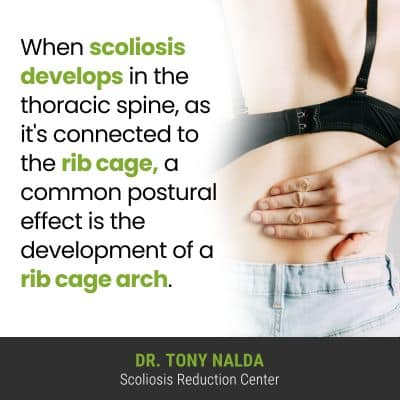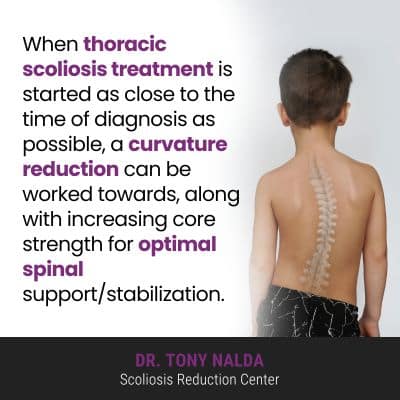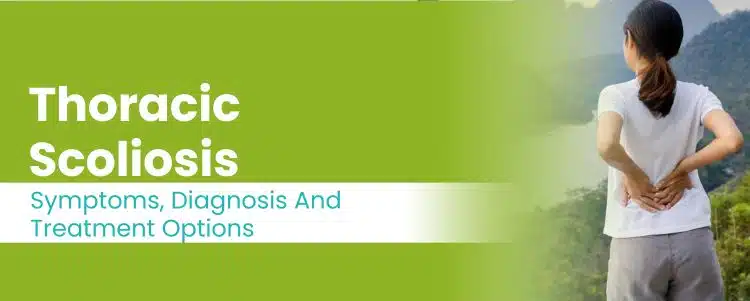Scoliosis can develop in any one section of the spine, or in more than one section as a combined scoliosis. Current estimates have close to seven million people living with the condition in the United States alone; awareness is needed to increase rates of early detection and intervention.
Scoliosis involves the development of an unnatural sideways-bending and rotating spinal curve, and if it develops in the middle/upper back, this is diagnosed as thoracic scoliosis. Symptoms will vary from patient to patient, and the complex nature of the condition necessitates the customization of treatment plans.
As part of the diagnostic process involves further classifying conditions based on key patient/condition variables, one of which is curvature location, let’s start there.
Diagnosing and Classifying Scoliosis
No two cases of scoliosis are the same, which is why treatment plans need to be fully customized.
Once scoliosis is diagnosed, conditions are further classified based on patient age, condition type, condition severity, and curvature location; classifying conditions not only streamlines the treatment process, but also informs the crafting of treatment plans.
Patient Age: Progression and Pain
Patient age is important because it indicates whether rapid growth is going to trigger rapid progression; growth is the condition’s trigger for progression.
As a progressive condition, scoliosis has it in its nature to get worse over time, and that means the size of the unnatural spinal curve is increasing, as are the condition’s uneven forces, and their effects.
Patient age is also important because it indicates whether a patient is likely to struggle with back pain or not; in most cases of childhood scoliosis, the condition isn’t commonly painful, and this is because scoliosis doesn’t become a compressive condition until skeletal maturity has been reached.
Patients who are still growing are experiencing a constant lengthening motion in their spines that counteracts the compressive force of the unnatural spinal curve, and it’s compression (uneven forces) that causes the majority of condition-related pain.
So patient age helps me gauge how much of a focus on counteracting progression is needed, along with whether or not pain management is going to be a necessary facet of scoliosis treatment.
Condition Type
There are different types of scoliosis people can develop; the most common type to affect both children and adults is idiopathic scoliosis: meaning cause unknown.
Approximately 80 percent of known cases are classified as idiopathic scoliosis, while the remaining 20 percent are associated with known causes: neuromuscular scoliosis, congenital scoliosis, and degenerative scoliosis.
These types with known causes are considered atypical, so they tend to have different symptoms and treatment needs.

For example, cases of neuromuscular scoliosis are caused by the presence of a larger neuromuscular condition such as cerebral palsy, spina bifida, and muscular dystrophy, to name a few.
As another medical condition has caused the scoliosis to develop, the underlying neuromuscular condition has to be the focus of treatment, and this complicates the treatment process and can make these cases particularly severe.
Congenital scoliosis is caused by a malformed spine that develops in utero, and degenerative scoliosis is caused by a combination of natural age-related spinal degeneration and the cumulative effect of certain lifestyle choices.
Condition Severity
When it comes to the types of symptoms a patient is going to experience, condition severity is a key factor because the more severe a condition is, the more noticeable its effects are likely to be.
Scoliosis can range from mild scoliosis to moderate and severe to very severe scoliosis, and severity is determined by a measurement known as Cobb angle, and the higher the Cobb angle, the larger the size of the scoliotic curve, and the more severe the condition:
- Mild scoliosis: Cobb angle measurement of between 10 and 25 degrees
- Moderate scoliosis: Cobb angle measurement of between 25 and 40 degrees
- Severe scoliosis: Cobb angle measurement of 40+ degrees
- Very-severe scoliosis: Cobb angle measurement of 80+ degrees
As a progressive condition, it’s important patients understand that where a scoliosis is at the time of diagnosis is not indicative of where it will stay; only proactive treatment options can work towards counteracting that progressive nature.
Curvature Location
There are three main spinal sections: the cervical spine (neck), the thoracic spine (middle/upper back), and the lumbar spine (lower back).
Curvature location is important not only because it tells me where to concentrate treatment, but also because it indicates the types of symptoms a patient might experience.
With most spinal conditions, the area of the body located closest to the affected spinal section is where the majority of its direct effects are going to be felt.
Scoliosis doesn’t just affect the spine, but also its surroundings and the entire body.
For example, when scoliosis develops in the cervical spine, it doesn’t just disrupt the neck’s ability to support the weight of the head and limit the neck’s range of motion, it can also cause headaches, shoulder and neck pain.
A common effect of lumbar scoliosis is sciatic nerve pain because the sciatic nerve starts in the lower back, so if the unnaturally-curved spine has exposed to uneven pressure, it can become inflamed, irritated, pinched, and/or impinged.
The thoracic spine is the most commonly affected by scoliosis.
What is Thoracic Scoliosis?
Scoliosis diagnosed in the middle/upper back is thoracic scoliosis.
The thoracic spine is the largest spinal section, containing 12 vertebrae (bones), so is vulnerable to a number of issues/conditions, one of which is scoliosis.
When scoliosis develops in the thoracic spine, as it’s connected to the rib cage, a common postural effect is the development of a rib cage arch.
Thoracolumbar scoliosis is a common curvature location, and this occurs as scoliosis develops in the upper lumbar spine and the lower thoracic spine as a combined scoliosis.
Thoracic scoliosis is diagnosed the same way all types are: through a combined physical examination and the results of a scoliosis X-ray.
The parameters that have to be met to reach a diagnosis of scoliosis includes the development of an unnatural sideways-bending spinal curve, but it also has to rotate, which is what makes scoliosis a 3-dimensional condition and sets it apart from a number of other spinal conditions that cause a loss of the spine’s healthy curves.
In addition, in order to be considered a true scoliosis, the size of the scoliotic curve has to be a minimum of 10 degrees (mild scoliosis).
Some common additional effects of thoracic scoliosis can include:
- The head being uncentered over the torso
- Uneven shoulders
- Uneven shoulder blades
- Uneven hips
- Arms and legs that hang at different lengths
As scoliosis progresses, these types of postural changes tend to become more noticeable, and additional changes can include disruptions to balance, coordination, and gait.
There are no guarantees, but early intervention is associated with treatment success, so what happens if thoracic scoliosis is left untreated?
Thoracic Scoliosis Treatment
Scoliosis treated proactively can be highly responsive, especially when mild, but regardless of the type, severity, or curvature location, the best time to start scoliosis treatment is always now; as a progressive condition, it only gets more complex to treat over time.
There are two main treatment choices for thoracic scoliosis: surgical treatment versus nonsurgical treatment.

Surgical intervention means spinal fusion, and once a spine is fused, it’s fused for life, and there are a number of potential risks, side effects, and complications that need to be considered carefully.
Modern conservative treatment, however, offers a surgical alternative with proactive chiropractic-centered treatment that integrates multiple scoliosis-specific treatment disciplines so conditions can be impacted on every level.
Chiropractic care is combined with physical therapy, scoliosis-specific exercises, a variety of additional therapies, corrective bracing, and rehabilitation.
When thoracic scoliosis treatment is started as close to the time of diagnosis as possible, a curvature reduction can be worked towards, along with increasing core strength for optimal spinal support/stabilization.
Thoracic scoliosis left untreated can lead to complications such as lung impairment, and while this is not a common effect and is more associated with severe curves, a rib cage arch can mean less room for the lungs to function optimally within; the biggest danger of leaving scoliosis untreated is progression to the point of needing invasive scoliosis surgery.
Conclusion
A diagnosis of thoracic scoliosis means an unnatural sideways-bending and rotating spinal curvature has developed in the middle/upper back, and the most common symptoms of scoliosis in children are postural changes, and the most common symptom of thoracic scoliosis in adults is pain.
Scoliosis pain can involve back pain, pain that radiates into the extremities due to spinal nerves being compressed in the spinal canal, and muscle spasms.
When thoracic scoliosis is treated proactively, there are fewer limits to what can be achieved, and developing scoliosis doesn’t have to mean a life of limitations, and it also doesn’t have to mean facing the risks and potential complications of spinal fusion surgery.
Conservative treatment for thoracic scoliosis has proven results, and this approach complements the spine’s movement-based design and preserves as much of its natural strength and function as possible.
Here at the Scoliosis Reduction Center®, my patients benefit from a chiropractic-centered treatment approach that combines chiropractic care with physical therapy, corrective bracing, and rehabilitation.




